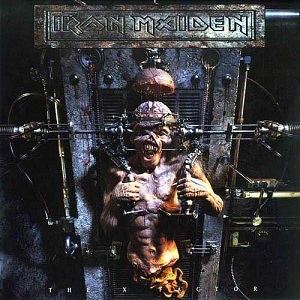Recorded 1994 – August 1995 Release date 2 October 1995 | Length 70:54 | |
 | ||
Released 2 October 1995 (1995-10-02) Similar Iron Maiden albums, Heavy metal albums | ||
10 the x factor 1995 iron maiden full album
The X Factor is the tenth studio album by English heavy metal band Iron Maiden, released on 2 October 1995 through EMI. It is the first of two albums by the band to include Blaze Bayley, formerly of Wolfsbane, as vocalist, replacing Bruce Dickinson who left the band following their previous tour to pursue a solo career. The album takes a darker tone than the band's first nine releases, due to the lyrics being based on personal issues surrounding Steve Harris at the time, who was in the midst of a divorce. This is reflected in the cover artwork, which graphically depicts the band's mascot, Eddie, being vivisected by machine.
Contents
- 10 the x factor 1995 iron maiden full album
- The x factor songbook the album tv ad
- Background
- Song details
- Critical reception
- Personnel
- Songs
- References
The x factor songbook the album tv ad
Background
The release's title came about at the start of the album's recording. According to producer Nigel Green:
"We all felt that the way things were progressing – the songs, Blaze's new involvement, the sound, the commitment – the new album really would have that extra quality, that bit of magic, that 'X Factor'. This became the working title for the album and we liked it, so we kept it. It is also very apt as this is our tenth studio album and "X" can bring up many images."
The X Factor's cover art depicts Eddie undergoing another lobotomy and was created by Hugh Syme. Due to the cover's "lifelike" style, the band were forced to release the album in a reversible sleeve, including a less graphic alternative, showing Eddie from a distance. The album was also the most recent one until The Book of Souls in 2015 to use the classic variant of the band's logo, as every single studio release from Virtual XI to The Final Frontier used an alternate variant that removed the extended ends of the "R", "M", and both "N's".
This album is also unusual for the band in that it produced several band compositions that did not make it onto the album, with Steve Harris commenting, "We actually ended up doing 14 songs and we used eleven, which is very unusual for us." All three songs, "I Live My Way", "Justice of The Peace" and "Judgement Day," were released as B-sides, the last two of which would also be featured on the Best of the 'B' Sides collection.
Supporting the album was the X Factour tour. Much like the tour for their following album, Virtual XI, several dates in the United States were cancelled as Bayley suffered from occasional vocal issues from the band's heavy concert schedule.
Song details
"Man on the Edge" and "Lord of the Flies" were released as singles. Both of these songs, and "Sign of the Cross," remained in Iron Maiden set lists following Bruce Dickinson's return. Live versions of these songs with Dickinson on vocals can be found on the single for "The Wicker Man" and the live albums Death on the Road and Rock in Rio respectively, while the same live takes of "Man on the Edge" and "Sign of the Cross" were later re-released on Iron Maiden's 2011 compilation album From Fear to Eternity.
"The Edge of Darkness" is based on the 1979 film Apocalypse Now, adapted from Joseph Conrad's Heart of Darkness, "Man on the Edge" is based on the 1993 movie, Falling Down, and "Lord of the Flies" is based on the William Golding novel of the same name. "Sign of the Cross" is based on the Umberto Eco's novel The Name of the Rose and is Iron Maiden's fourth longest song at more than 11 minutes in length. Live versions of "Blood on the World's Hands" and "The Aftermath" can be found in Best of the 'B' Sides compilation album.
Blaze Bayley recorded a re-arranged version of "Sign of the Cross" on the live album As Live as It Gets.
Critical reception
The X Factor was met with lukewarm responses from critics. AllMusic rated the album two stars out of five, stating that "suffering from a lack of powerful riffs and tightly written songs, The X Factor is a lackluster latter-day album from Iron Maiden. Although the band doesn't sound particularly bad on the record, they don't sound inspired and there's a noticeable lack of energy to the performances which makes the lack of imagination all the more apparent."
Sputnikmusic were somewhat more positive about the release, deeming the album "a change for Iron Maiden, and a very important one at that" as it "paved the way for future albums of similar length." They also praised the "often criticized" Blaze Bayley, whose voice they claimed "was perfect for the new release."
Personnel
Production and performance credits are adapted from the album liner notes.
Songs
1Sign of the Cross11:17
2Lord of the Flies5:04
3Man on the Edge4:13
